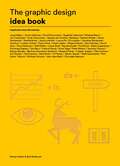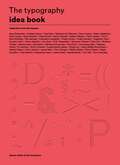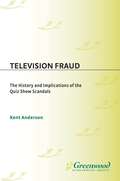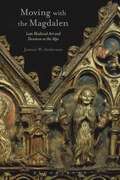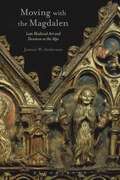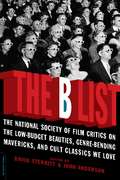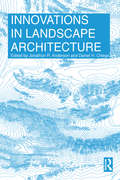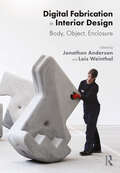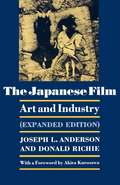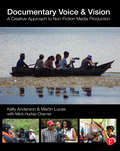- Table View
- List View
Tweed (Textiles that Changed the World)
by Fiona AndersonThe story of tweed is tied to a series of social, economic and cultural shifts that have molded its development. This book considers the historical factors that helped to shape the design characteristics and social meanings of the group of fabrics that we call tweed, from their emergence in the 1820s to the present day. Including significant new research on tweeds, from Harris Tweed to the type used by Chanel, this book follows the history of these fabrics from the raw fiber to the finished garment in men's and women's fashion.Exploring rural and urban contexts, this book reveals the important physical and conceptual relationships of tweed with landscape. Anderson shows that, contrary to their strong popular associations with tradition, tweeds emerged in the Romantic era as a response to the dramatic changes associated with industrialization and urbanization. Progressive changes in gender relations are also explored as a major factor in tweed's evolution, from associations with particular ideals of masculinity into what is now a truly adaptable fashion textile worn by both sexes. This is the first book of its kind to recognize the importance of tweed to fashion innovation today.
The Graphic Design Idea Book: Inspiration from 50 Masters
by Gail Anderson Gaile Anderson Steven HellerThis book serves as an introduction to the key elements of good design.Broken into sections covering the fundamental elements of design, key works by acclaimed designers serve to illustrate technical points and encourage readers to try out new ideas. Themes covered include narrative, colour, illusion, ornament, simplicity, and wit and humour.The result is an instantly accessible and easy to understand guide to graphic design using professional techniques.
The Typography Idea Book: Inspiration from 50 Masters
by Gail Anderson Gaile Anderson Steven HellerThe latest in this successful series, this book features around 150 of the most important buildings in the history of world architecture – from the pyramids and Parthenon to some of the most significant works by recent architects. The buildings are organized by type – from places of worship and public buildings to houses – and are divided into nine chapters, each with an informative introduction that surveys the history of that type. For each building there are numerous, accurate scale drawings showing a combination of floor plans, elevations and sections as appropriate, all specially redrawn for this book. The quality and number of the line drawings, together with the authoritative text by a renowned architectural historian, allow all the buildings to be understood in detail and make this an invaluable resource for students.
A Bridge to the Sky: The Arts of Science in the Age of 'Abbas Ibn Firnas
by Glaire AndersonIn times of widespread Islamophobia, there is an understandable motivation for constructing scientific achievement as a counternarrative in popular discourse about Islam. Yet doing so has tended to impose an anachronistic conception of "science" onto pre-modern practices while also obscuring wider views of the intellectual, philosophical, and particularly the material context of medieval scientific achievement. An exemplary case study for this phenomenon is the figure of 'Abbas Ibn Firnas (d. 887), a celebrated early scientist, C?rdoban courtier, and polymath. Ibn Firnas is best known today for conducting an early aeronautics experiment, which was commemorated by NASA. Some historians have called it the first successful human flight. The earliest and fullest account of Ibn Firnas' career in the Umayyad court includes the aeronautics experiment, and a great deal more on his achievements in the arts and design but has yet to receive sustained scholarly attention. That account, as preserved in a volume of the Muqtabas of Ibn Hayyan (d. 1076), the Cordoban court chronicle, presents Ibn Firnas as both the leading intellectual of early Islamic Iberia and as a pioneering figure in the design and construction of the court's first fine scientific instruments and space of scientific visualization. A Bridge to the Sky reconstructs the account of Ibn Firnas' career to explore the exact sciences, design, and making as interconnected intellectual practices during the first flowering of the Islamic scientific revolution. Glaire D. Anderson deftly weaves analyses of the Arabic texts alongside the striking contemporaneous visual evidence, including some of the earliest surviving Islamic scientific instruments and illustrated treatises that are, as argued here, also works of art. A Bridge to the Sky thus offers both an intellectual biography of the intriguing figure of Ibn Firnas alongside an exploration of the culture of scientific learning in Umayyad al-Andalus. As a novel examination of the social significance of science, design and craftsmanship in medieval Iberia and the Islamic lands during the "classical" period of Islamic civilization, A Bridge to the Sky opens new avenues of study in the fields of medieval Islamic studies and art history, visual and material culture studies, and history of science.
A Bridge to the Sky: The Arts of Science in the Age of 'Abbas Ibn Firnas
by Glaire AndersonIn times of widespread Islamophobia, there is an understandable motivation for constructing scientific achievement as a counternarrative in popular discourse about Islam. Yet doing so has tended to impose an anachronistic conception of "science" onto pre-modern practices while also obscuring wider views of the intellectual, philosophical, and particularly the material context of medieval scientific achievement. An exemplary case study for this phenomenon is the figure of 'Abbas Ibn Firnas (d. 887), a celebrated early scientist, C?rdoban courtier, and polymath. Ibn Firnas is best known today for conducting an early aeronautics experiment, which was commemorated by NASA. Some historians have called it the first successful human flight. The earliest and fullest account of Ibn Firnas' career in the Umayyad court includes the aeronautics experiment, and a great deal more on his achievements in the arts and design but has yet to receive sustained scholarly attention. That account, as preserved in a volume of the Muqtabas of Ibn Hayyan (d. 1076), the Cordoban court chronicle, presents Ibn Firnas as both the leading intellectual of early Islamic Iberia and as a pioneering figure in the design and construction of the court's first fine scientific instruments and space of scientific visualization. A Bridge to the Sky reconstructs the account of Ibn Firnas' career to explore the exact sciences, design, and making as interconnected intellectual practices during the first flowering of the Islamic scientific revolution. Glaire D. Anderson deftly weaves analyses of the Arabic texts alongside the striking contemporaneous visual evidence, including some of the earliest surviving Islamic scientific instruments and illustrated treatises that are, as argued here, also works of art. A Bridge to the Sky thus offers both an intellectual biography of the intriguing figure of Ibn Firnas alongside an exploration of the culture of scientific learning in Umayyad al-Andalus. As a novel examination of the social significance of science, design and craftsmanship in medieval Iberia and the Islamic lands during the "classical" period of Islamic civilization, A Bridge to the Sky opens new avenues of study in the fields of medieval Islamic studies and art history, visual and material culture studies, and history of science.
Make Your Own Pure Mineral Makeup: 79 Easy Hypoallergenic Recipes for Radiant Beauty
by Heather AndersonFree of harmful irritants and artificial additives, these recipes teach you to make effective custom-colored eye shadows, foundations, concealers, and more at home, with easily obtained and inexpensive ingredients that are safe even for those with sensitive skin.
Final Cut Pro X Efficient Editing: Smart, quick, and effective video editing with FCP X 10.4.10
by Iain AndersonFrom basic editing workflows to finishing and exporting your final cut, explore the features of Final Cut Pro X with this practical guideKey FeaturesExplore the best ways to use FCP X, from importing and editing to finishing and exporting the final cutUnlock the power of editing in the magnetic timeline to make huge changes or subtle adjustments easilyFinish your project with pro-level color correction, effects, transitions, audio, titles, and captionsBook DescriptionFinal Cut Pro X (FCP X) is Apple's efficient and accessible video editing software for everyone, but it offers powerful features that experienced editors will find useful too. FCP X is the quickest way to transform your raw clips into a finished piece, so if speed is important, make this a key tool in your editing arsenal.Final Cut Pro X Efficient Editing is a comprehensive best practice guide for all editors. You'll not only learn how to use the features but also find out which ones are the most important and when you should use them. With the help of practical examples, the book will show you how typical footage can be assembled, trimmed, colored, and finessed to produce a finished edit, exploring a variety of techniques. As you progress through the book, you'll follow a standard editing workflow to get the feel of working on real-world projects and answer self-assessment questions to make sure that you're on track.By the end of this Final Cut Pro X book, you'll be well versed with the key features of this app and have all the tools you need to create impressive edits.What you will learnUnderstand the media import process and delve into media managementEffectively organize your footage so you can find the right shot quicklyDiscover how to assemble a rough cut editExplore trimming and advanced editing techniques to finesse and finalize the editEnhance the edit with color correction, effects, transitions, titles, captions, and much moreSweeten the audio by controlling volume, using compression, and adding effectsShare the final edited video and archive the jobWho this book is forThe book is for creative professionals, anyone starting out in video editing, and editors switching to Final Cut Pro X from another video editing system. Whether you are a beginner or a professional, you'll find this FCPX book useful. All you need to get started is familiarity with macOS.
Television Fraud: The History and Implications of the Quiz Show Scandals (Contributions in American Studies)
by J. Kent AndersonAnderson provides an unprecedented probe into the inner workings of the quiz shows. He details their honest beginnings and explains how the practice of supplying answers grew out of a desire to keep popular contestants on the air as long as possible to boost ratings.
Basics Architecture 03: Architectural Design (Basics Architecture)
by Jane AndersonBasics Architecture 03: Architectural Design explains the process of designing architectural projects. It describes the design studio and the activities that take place there.The architectural design process is as diverse as the people who practise it; all architects follows their own individual design process. In this dynamic new text the realities of the design process and the relationship between education and practice are explored in detail.The book introduces a variety of processes through examples and case studies. This allows readers to identify with certain methods with which they could respond to in their own work, and enables them to develop their own unique approach.
The Green Guide to Specification: An Environmental Profiling System for Building Materials and Components
by Jane Anderson David Shiers Mike SinclairHow can you tell if the materials and components you are specifying have a low environmental impact? A full life-cycle assessment is a complex, time-consuming and expensive process; the environmental ratings summarised in this Guide provide a quick and easy way for designers and specifiers to assess their options. The relative environmental performance of over 250 materials and components have been assessed in this guide, using carefully researched, quantitative data derived from the BRE Environmental Database. A wide range of alternative specifications are provided for: · walls · floor systems · floor finishes · roofs · windows · doors · ceilings · paints · insulation · landscaping. The performance of each specification is measured against a range of environmental impacts including: · climate change · toxicity · fossil fuel and ozone depletion · levels of emissions and pollutants · mineral and water extraction. Environmental performance is indicated by a simple to use A-B-C rating system. To further aid specifiers, guidance on capital coasts, typical replacement intervals and information on recycling is also provided for each material and component. An important part of BREEAM, the BRE's widely accepted scheme to improve the environmental performance of buildings, The Green Guide to Specification is an essential tool for architects, surveyors, building managers and property owners seeking to reduce the environmental impacts of building materials through informed choice.
Moving with the Magdalen: Late Medieval Art and Devotion in the Alps
by Joanne W. AndersonMoving with the Magdalen is the first art-historical book dedicated to the cult of Mary Magdalen in the late medieval Alps. Its seven case study chapters focus on the artworks commissioned for key churches that belonged to both parish and pilgrimage networks in order to explore the role of artistic workshops, commissioning patrons and diverse devotees in the development and transfer of the saint's iconography across the mountain range. Together they underscore how the Magdalen's cult and contingent imagery interacted with the environmental conditions and landscape of the Alps along late medieval routes.
Moving with the Magdalen: Late Medieval Art and Devotion in the Alps
by Joanne W. AndersonMoving with the Magdalen is the first art-historical book dedicated to the cult of Mary Magdalen in the late medieval Alps. Its seven case study chapters focus on the artworks commissioned for key churches that belonged to both parish and pilgrimage networks in order to explore the role of artistic workshops, commissioning patrons and diverse devotees in the development and transfer of the saint's iconography across the mountain range. Together they underscore how the Magdalen's cult and contingent imagery interacted with the environmental conditions and landscape of the Alps along late medieval routes.
Touring and Publicizing England's Country Houses in the Long Eighteenth Century
by Jocelyn AndersonOver the course of the long 18th century, many of England's grandest country houses became known for displaying noteworthy architecture and design, large collections of sculptures and paintings, and expansive landscape gardens and parks. Although these houses continued to function as residences and spaces of elite retreat, they had powerful public identities: increasingly accessible to tourists and extensively described by travel writers, they began to be celebrated as sites of great importance to national culture. This book examines how these identities emerged, repositioning the importance of country houses in 18th-century Britain and exploring what it took to turn them into tourist attractions.Drawing on travel books, guidebooks, and dozens of tourists' diaries and letters, it explores what it meant to tour country houses such as Blenheim Palace, Chatsworth, Wilton, Kedleston and Burghley in the tumultuous 1700s. It also questions the legacies of these early tourists: both as a critical cultural practice in the 18th century and an extraordinary and controversial influence in British culture today, country-house tourism is a phenomenon that demands investigation.
Touring and Publicizing England's Country Houses in the Long Eighteenth Century
by Jocelyn AndersonOver the course of the long 18th century, many of England's grandest country houses became known for displaying noteworthy architecture and design, large collections of sculptures and paintings, and expansive landscape gardens and parks. Although these houses continued to function as residences and spaces of elite retreat, they had powerful public identities: increasingly accessible to tourists and extensively described by travel writers, they began to be celebrated as sites of great importance to national culture. This book examines how these identities emerged, repositioning the importance of country houses in 18th-century Britain and exploring what it took to turn them into tourist attractions.Drawing on travel books, guidebooks, and dozens of tourists' diaries and letters, it explores what it meant to tour country houses such as Blenheim Palace, Chatsworth, Wilton, Kedleston and Burghley in the tumultuous 1700s. It also questions the legacies of these early tourists: both as a critical cultural practice in the 18th century and an extraordinary and controversial influence in British culture today, country-house tourism is a phenomenon that demands investigation.
Theatre and Photography (Theatre And)
by Joel AndersonExamining the relationship between theatre and photography, this book shows how the two intertwine and provide vantage points for understanding each other. Joel Anderson explores the theory and practice of photographing theatre and performance, as well as theatre and photography's mutual preoccupation with posing, staging, framing, and stillness.
Theatre and Photography (Theatre And)
by Joel AndersonExamining the relationship between theatre and photography, this book shows how the two intertwine and provide vantage points for understanding each other. Joel Anderson explores the theory and practice of photographing theatre and performance, as well as theatre and photography's mutual preoccupation with posing, staging, framing, and stillness.
Christianity and democratisation: From pious subjects to critical participants (PDF) (Perspectives on Democratic Practice)
by John AndersonThis book examines the contribution of different Christian traditions to the waves of democratisation that have swept various parts of the world in recent decades. It offers a historical overview of Christianity’s engagement with the development of democracy, before focusing in detail on the period since the 1970s. Successive chapters deal with: the Roman Catholic conversion to democracy and the contribution of that church to democratisation; the Eastern Orthodox ‘hesitation’ about democracy; the alleged threat to American democracy posed by the politicisation of conservative Protestantism; and the likely impact on democratic development of the global expansion of Pentecostalism. The author draws out several common themes from the analysis of these case studies, the most important of which is the ‘liberal-democracy paradox’. This ensures that there will always be tensions between faiths that proclaim some notion of absolute truth and political orders that are rooted in the idea of compromise, negotiation and bargaining. Written in an accessible style, this book will appeal to students of politics, sociology and religion, and prove useful on a range of advanced undergraduate and postgraduate courses.
Christianity and democratisation: From pious subjects to critical participants (Perspectives on Democratic Practice)
by John AndersonThis book examines the contribution of different Christian traditions to the waves of democratisation that have swept various parts of the world in recent decades. It offers a historical overview of Christianity’s engagement with the development of democracy, before focusing in detail on the period since the 1970s. Successive chapters deal with: the Roman Catholic conversion to democracy and the contribution of that church to democratisation; the Eastern Orthodox ‘hesitation’ about democracy; the alleged threat to American democracy posed by the politicisation of conservative Protestantism; and the likely impact on democratic development of the global expansion of Pentecostalism. The author draws out several common themes from the analysis of these case studies, the most important of which is the ‘liberal-democracy paradox’. This ensures that there will always be tensions between faiths that proclaim some notion of absolute truth and political orders that are rooted in the idea of compromise, negotiation and bargaining. Written in an accessible style, this book will appeal to students of politics, sociology and religion, and prove useful on a range of advanced undergraduate and postgraduate courses.
The B List: The National Society of Film Critics on the Low-Budget Beauties, Genre-Bending Mavericks, and Cult
by John Anderson David SterrittWhat kind of collection could possibly find common ground among The Son of Kong, Platoon, and Pink Flamingos? What kind of fevered minds could conceive of such a list? What are the unheard-of qualities that tie them all together?The answers: This book. The National Society of Film Critics. And the far-reaching enticements of the B movie itself.Once the B movie was the Hollywood stepchild, the underbelly of the double feature. Today it is a more inclusive category, embracing films that fall outside the mainstream by dint of their budgets, their visions, their grit, and occasionally—sometimes essentially—their lack of what the culture cops call &“good taste.&”The films in The B List are offbeat, unpredictable, and decidedly idiosyncratic. And that&’s why we love them.
Innovations in Landscape Architecture
by Jonathon R. Anderson Daniel H. OrtegaThis inspiring and thought-provoking book explores how recent innovations in landscape architecture have uniquely positioned the practice to address complex issues and technologies that affect our built environment. The changing and expanding nature of "landscape" make it more important than ever for landscape architects to seek innovation as a critical component in the forward development of a contemporary profession that merges expansive ideas and applications. The editors bring together leading contributors who are experts in new and pioneering approaches and technologies within the fields of academic and professional landscape architecture. The chapters explore digital technology, design processes and theoretical queries that shape the contemporary practice of landscape architecture. Topics covered include: Digital design Fabrication and prototyping Emerging technology Visualization of data System theory Concluding the book are case studies looking at the work of two landscape firms (PEG and MYKD) and two academic departments (Illinois Institute of Technology and the Rhode Island School of Design), which together show the novel and exciting directions that landscape is already going in.
Innovations in Landscape Architecture
by Jonathon R. Anderson Daniel H. OrtegaThis inspiring and thought-provoking book explores how recent innovations in landscape architecture have uniquely positioned the practice to address complex issues and technologies that affect our built environment. The changing and expanding nature of "landscape" make it more important than ever for landscape architects to seek innovation as a critical component in the forward development of a contemporary profession that merges expansive ideas and applications. The editors bring together leading contributors who are experts in new and pioneering approaches and technologies within the fields of academic and professional landscape architecture. The chapters explore digital technology, design processes and theoretical queries that shape the contemporary practice of landscape architecture. Topics covered include: Digital design Fabrication and prototyping Emerging technology Visualization of data System theory Concluding the book are case studies looking at the work of two landscape firms (PEG and MYKD) and two academic departments (Illinois Institute of Technology and the Rhode Island School of Design), which together show the novel and exciting directions that landscape is already going in.
Digital Fabrication in Interior Design: Body, Object, Enclosure
by Jonathon Anderson Lois WeinthalDigital Fabrication in Interior Design: Body, Object, Enclosure draws together emerging topics of making that span primary forms of craftsmanship to digital fabrication in order to theoretically and practically analyze the innovative and interdisciplinary relationship between digital fabrication technology and interior design. The history of making in interior design is aligned with traditional crafts, but a parallel discourse with digital fabrication has yet to be made evident. This book repositions the praxis of experimental prototyping and integrated technology to show how the use of digital fabrication is inherent to the interior scales of body, objects and enclosure. These three scales act as a central theme to frame contributions that reinforce the interdisciplinary nature of interior design and reinterpret traditional crafts by integrating new methods of making into conventional workflows. Featuring significant international practitioners and researchers, the selected contributions represent the ever-increasing interdisciplinary nature of design, demonstrating a breadth of disciplines. A foundational text for interiors students and practitioners, Digital Fabrication in Interior Design expands the necessary dialogue about digital fabrication at the scale of interiors to inform design theory and practice.
Digital Fabrication in Interior Design: Body, Object, Enclosure
by Jonathon Anderson Lois WeinthalDigital Fabrication in Interior Design: Body, Object, Enclosure draws together emerging topics of making that span primary forms of craftsmanship to digital fabrication in order to theoretically and practically analyze the innovative and interdisciplinary relationship between digital fabrication technology and interior design. The history of making in interior design is aligned with traditional crafts, but a parallel discourse with digital fabrication has yet to be made evident. This book repositions the praxis of experimental prototyping and integrated technology to show how the use of digital fabrication is inherent to the interior scales of body, objects and enclosure. These three scales act as a central theme to frame contributions that reinforce the interdisciplinary nature of interior design and reinterpret traditional crafts by integrating new methods of making into conventional workflows. Featuring significant international practitioners and researchers, the selected contributions represent the ever-increasing interdisciplinary nature of design, demonstrating a breadth of disciplines. A foundational text for interiors students and practitioners, Digital Fabrication in Interior Design expands the necessary dialogue about digital fabrication at the scale of interiors to inform design theory and practice.
The Japanese Film: Art and Industry
by Joseph L. Anderson Donald RichieTracing the development of the Japanese cinema from 1896 (when the first Kinetoscope was imported) through the golden ages of film in Japan up to today, this work reveals the once flourishing film industry and the continuing unique art of the Japanese film. Now back in print with updated sections, major revaluations, a comprehensive international bibliography, and an exceptional collection of 168 stills ranging over eight decades, this book remains the unchallenged reference for all who seek a broad understanding of the aesthetic, historical, and economic elements of motion pictures from Japan.
Documentary Voice & Vision: A Creative Approach to Non-Fiction Media Production
by Kelly Anderson Martin LucasLearn the creative and technical essentials of documentary filmmaking with Documentary Voice & Vision. This comprehensive work combines clear, up-to-date technical information, production techniques and gear descriptions with an understanding of how technical choices can create meaning and serve a director’s creative vision. Drawing on the authors’ years of experience as documentary filmmakers, and on interviews with a range of working professionals in the field, the book offers concrete and thoughtful guidance through all stages of production, from finding and researching ideas to production, editing and distribution. Documentary Voice & Vision will help students and aspiring filmmakers think though research and story structure, ethics, legal issues and aesthetics, as well as techniques from camera handling to lighting, sound recording and editing. The book explores a full range of production styles, from expository to impressionistic to observational, and provides an overview of contemporary distribution options. Documentary Voice & Vision is a companion text to Mick Hurbis-Cherrier’s Voice & Vision: A Creative Approach to Narrative Film and DV Production, and employs a similar style and approach to that classic text. This text is written from the perspective of documentary filmmakers, and includes myriad examples from the world of non-fiction filmmaking. A robust companion website featuring additional resources and interactive figures accompanies the book.

